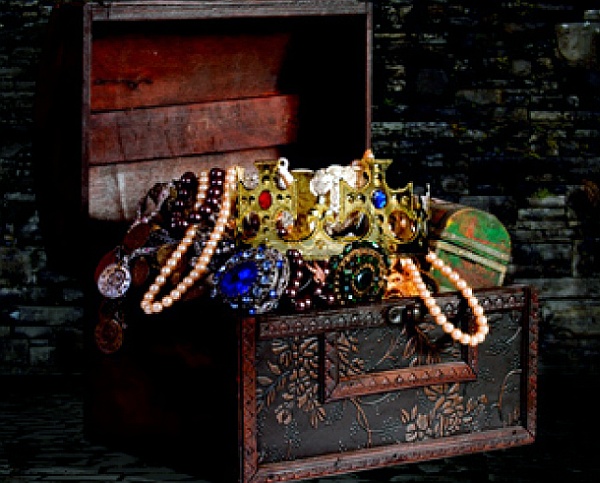King John's Lost Treasure
- Details
- Written by AndEl

John, King of England from 1199–1216, is remembered today for many reasons, most of them unfavourable. To children he is best known as the arch-villain in the Robin Hood story, and in history he is remembered as ‘bad king John’, who lost most of the overseas possessions of the Angevin empire, irritated the barons so much that he was forced to sign the Magna Carta in 1215, and lost his Crown Jewels in the Wash. The legend of John’s lost treasure has been handed down and grown in the telling for 700 years, largely by word of mouth, and anyone brought up in the Fens has heard it from an early age.
John was born on Christmas Eve, the youngest son of Henry II and his wife Eleanor of Aquitaine. As a child, John tended to be overshadowed by is older brother Richard. Like his father, John developed a reputation for violent rages which lead to him foaming at the mouth. Henry left no land to John when he died so John was given the nick-name John Lackland.
In 1189, all of Henry's territory went to his oldest son, Richard I, better known as Richard the Lionheart. In 1199, Richard was killed in France and John became the king of England. His reign started in an unfortunate way. In 1202, John's nephew, Arthur of Brittany, was murdered. Many in Brittany believed that John was responsible for his murder and they rebelled against John.
In 1204, John's army was defeated in Brittany and John had no choice but to retreat. His military standing among the nobles fell and he was given a new nickname - John Softsword. The defeat in north France was a major blow for John and a costly one. To pay for the defeat, John increased taxes which was not popular with anybody other than John and his treasurers. John also succeeded in falling out with the pope in 1207. John quarreled with the pope over who should be Archbishop of Canterbury. The pope excommunicated John and put England under a Medieval Church law that stated that no christening or marriage would be legal until the time the pope said that they would be. Medieval Church law said that only christened people could get to Heaven while children born out of marriage were doomed to Hell. This placed people in England under a terrible strain and they blamed one person for this - John.
In 1213, John had to give in and surrender the spiritual well-being of the whole country to the pope. However, the pope never fully trusted John and in 1214, the pope proclaimed that anybody who tried to overthrow John would be legally entitled to do so. In the same year, John lost another battle to the French at Bouvines. This defeat resulted in England losing all her possessions in France. This was too much for the powerful barons in England. In 1214, they rebelled. John was forced to sign the Magna Carta at Runnymede in 1215. This guaranteed the people of England rights that the king could not go back on. In 1216, John tried to go back but this only provoked the barons into declaring war on him. By 1216, John was ill. During the war, he suffered from dysentery.
The basic story of his lost treasures, as related by historians from the 13th century onwards, is that King John was travelling in the East of England in late 1216. By the autumn of 1216, John’s fortunes had sunk to a new low. He had inherited the mighty Angevin empire in England and France forged by his father Henry II, pawned to pay for the crusades by his brother Richard – and squandered by himself. Having already lost his lands in Normandy to the French king, he had faced a rampaging French army on his own soil aided and abetted by his own rebellious barons. The previous year he had been forced by them to sign the Magna Carta, reducing the powers of the crown. Although he had won some victories since then, he had earlier been ex-communicated by the pope and his whole country had been placed under an interdict from Rome – every church in England was ordered to be closed.
On October 9, 1216, though, he arrived in Lynn, one of the few places where he was still popular. He had journeyed from Lincolnshire to Bishop’s Lynn (now King’s Lynn) in Norfolk, but when he arrived he began to feel ill. It was decided that he would return back towards Lincolnshire, which was probably thought to be safer at this time, as the French king, Louis, had recently invaded the country to the south. On 12 October, John attempted to cross the Wash, the large bay that separates East Anglia from Lincolnshire. At this time it extended much further inland than it does today, and would have been a region of mudflats and marshes, traversable at low tide but dangerous to the unwary, riddled with quicksand and deeper channels and vulnerable to rapid movements of water with the tide.
The king is said to have crossed over at Wisbech, where it was possible to ford the Wellstream, one of the rivers running into the Wash. Meanwhile the king’s baggage train, which supposedly included all of the royal treasures including the Crown Jewels (the regalia the monarch bore during the coronation), was also trying to cross the Wash, but was surprised by the tide and got lost amidst the rising waters and quicksand. The traditional account of this disaster is well represented by this passage from Charles Dickens’ A Child’s History of England’: “looking back from the shore when he was safe, he [the king] saw the roaring water sweep down in a torrent, overturn the waggons, horses, and men, that carried his treasure, and engulf them in a raging whirlpool from which nothing could be delivered.” Undone by this tremendous stroke of ill fortune, John was taken to the monastery at Swineshead Abbey in Lincolnshire where he was greeted with ‘quantities of pears, and peaches, and new cider’. He was taken ill again, with dysentery, and moved a few more times, eventually dying on the 18 October at Newark.
Historians disagree about many aspects of this tale. For would-be treasure hunters, one of the most interesting issues is the question of what the king actually lost. Although it is traditionally said that he lost the Crown Jewels, there is no contemporary record that says exactly this. Roger de Wendover’s Flores Historiarum (Flowers of History), written around 1230, gives the lost loot as ‘treasures, precious vessels, and all the other things which he cherished with special care’. Ralph of Coggeshall’s Chronicon Anglicanum describes it as ‘his chapel with its relics … and diverse household effects’. Another source describes the king’s ‘pricely carriage and furniture’. In his book “Undiscovered”, Ian Wilson surveys the theories about John’s lost treasure and points out that the official records of the time show that the king was moving round the countryside at quite a rate – sometimes as much as 60 kilometres (37 miles) a day. This suggests that he was not accompanied by a large baggage train, which in that day and age would have been extremely sluggish. So perhaps the contemporary accounts are exaggerated. Set against this is the evidence that genuinely valuable treasure was lost that October day.
King John’s favourite hobby was collecting jewellery, while as monarch he also owned a hoard of gold and silver plate and other valuables, which he had spent much of 1215 and 1216 gathering together from the various monasteries where it was deposited. Of particular value were the imperial regalia he had inherited from his grandmother, the Empress of Germany, which made up part of his Crown Jewels. During John’s reign all this treasure is listed in the royal inventories called the Rolls (which John himself instituted), but most of it is absent from the inventory of regalia used during the coronation of John’s successor, Henry III in 1220. In other words, it seems likely that a priceless collection of royal valuables did indeed disappear.
The central issue is the probable location of the disaster. The coastline in this region is much changed since the Middle Ages. Drainage projects in later centuries reclaimed a lot of land and radically altered the way that sediment was deposited, and the coastline advanced many kilometres. Wisbech in particular, which used to be close to the sea, is now several kilometres inland. For treasure hunters this is potentially encouraging, because it means that where the jewels were lost is now dry land, but it also means that the paths, fords and causeways used to cross the Wash in medieval times now exist as relicts only, occasionally identifiable from the air or as the basis for modern parish boundaries or roads. On top of this there is serious disagreement about whether John was travelling with or separately from his baggage train, and which route would have been taken in either scenario.
Most modern sources confidently state that John was travelling separately from his baggage train. While he had gone the long way round the Wash, via Wisbech, his train was taking a short cut across the Wash, presumably to make up for the fact that it moved more slowly than he did. As Wilson points out in “Undiscovered”, however, the contemporary sources specifically state that the king barely escaped the disaster, which suggests he was with the baggage train when it was overcome. If the train was indeed carrying his collected loot, he probably would have been loath to let it out of his sight. Safety would have been a particular issue because of the unsettled times and the fact that the fenland of Lincolnshire was hostile territory where the Norman monarchy had never been popular. (This area had been the haunt of the 11th-century rebel Hereward the Wake, a historical figure who was one of the main sources for the legendary figure of Robin Hood.) These considerations are of prime importance, because it is known that John did cross the Wellstream at Wisbech. If his baggage train was with him, it must have crossed there too. The Wellstream no longer exists, but the River Nene flows more or less in the same course.
Wilson describes three theories about the exact site of the disaster. For many years the traditional view was that the baggage train crossed separately from John, travelling from Cross Keys on the western side of the Wash to Long Sutton on the eastern side, and being overwhelmed near present-day Sutton Bridge. Many treasure hunters have looked in this area, without success. Historian Gordon Fowler, assuming that the baggage train was with the king, has pinpointed the likely crossing point of the Wellstream as being just between Wisbech and Walsoken (although today these are now more or less the same town). He even suggested an explanation for the disaster – the sudden appearance of a tidal bore, known as an eagre in that region, which is where a tidal surge funnels water up a river as a series of large, potentially destructive waves. A third candidate – based on the theory of historian J C Holt that the traditional crossing point of the Wellstream in those days was to the north of Wisbech, between Walpole and Foul Anchor – puts the location near modern-day Tydd Gote. There is evidence in this region of medieval quicksand beds, which ties in with the contemporary accounts of the disaster.
More recently a fourth candidate has emerged, based on a reconstruction of the exact tide tables for that day in 1216, which suggests that the baggage train would have got further than the Wellstream by the time the rising tide caught up with it, and was probably crossing the mouth of the Welland River at modernday Fosdyke, to the north-east of Wisbech. With so many candidate locations it is hard for a treasure hunter to know where to look, and any search will not be helped by the 10 metres (33 feet) of soil believed to have accumulated over the previous ground level in the last 800 years, which puts the treasure well beyond the range of normal metal detectors. However, this may be only part of the problem. Various sub-plots and intrigues behind the traditional story suggest that the treasure may not be there after all.
After John’s death, rumours proliferated that he had been poisoned, probably via those ‘quantities of pears, and peaches, and new cider’ laid out for him by the monks of Swineshead. Although most modern historians discount these rumours, not everyone agrees, and medieval conspiracy theories have been advanced, based on the ‘coincidence’ between the loss of the king’s treasure and his untimely death. Another theory suggests that the Crown Jewels were not lost at all, but were either sold/used by John as collateral for loans, with the Wash incident being staged as a kind of misdirection or medieval fraud.Whatever maleficent plan the king was hatching was cut short by his premature death/murder, and the treasure was subsequently stolen.
At least one contemporary report speaks of suspiciously heavily laden men seen leaving Newark in the wake of his death. There’s absolutely no evidence for this, but it makes a good story. The ailing king made it to Newark Castle, where he died, aged 49, on October 18, just two days after re-entering Lincolnshire. He was buried at Worcester – minus his missing regalia. Maybe someone else did make off with the loot and the lost treasure in The Wash story was just a ruse to cover the glaring absence of the jewels. Certainly it reinforces the negative image of King John that even recent revisionist historians have not been able to change. We have to ask if a suspicious character like John would really travel without his most precious jewels.
If the treasure is really buried somewhere near modern-day Sutton Bridge, then it would be covered by 20 feet or more of silt, so we can all put our metal detectors away. But that hasn’t stopped people looking. During the 1930s a group of American treasure hunters paid local farmers 2s 6d an acre for their help in looking for the jewels at Walpole Island. More recently a team from Nottingham University took soil samples in a bid to discover the causeway the wagon train used. The search goes on. We may never know the truth.
In the 14th century it was commonly rumoured that Robert, Lord Tiptoft, had salvaged the treasure, setting himself up as a wealthy man in the north country on the proceeds. According to East Anglian folklorist W A Dutt, local legend in the Sutton area talks of King John’s Hole, a pool where the jewels were hidden, either by John himself for some nefarious purpose, or by those who recovered them after the disaster in the Wash. The pool is said to be on the southern side of the King’s Lynn to Long Sutton Road. But it is possible that this booty hidden in the hole has already been recovered. In the 14th century local baron Robert, third Lord Tiptoft, suddenly became immensely wealthy. There was no apparent source for his sudden affluence, and rumours spread that Tiptoft had discovered King John’s lost treasure. So perhaps there is nothing out there left to recover …
Liked this article? Dive deeper into personal growth and wellness! Check out CrystalWind.ca for spiritual wisdom or explore AromaWorx.ca for natural well-being tips. Spread the positivity—share this with friends on their happiness journey!
Let’s Chat! Drop Your Thoughts Below! ![]()
Latest Articles

Imagine a world of inspiration and healing, free for all—made possible by YOU!
Donate Now—Ignite the Magic at CrystalWind.ca!

Epilepsy - Finding A Cure
Your donation can make a difference!
Help us find a cure – donate now!
Unlock Your Light: Join Lightworkers Worldwide on CrystalWind.ca!
Quake Watch
Articles: Lost Treasure
Articles: Shambhala
Follow Us!
Who is Online Now
We have 39648 guests and no members online
Featured This Month
Sun in Taurus
Sun in Taurus April 21 through May 21 An Overview of Sun Sign Characteristi... Read more
The Time of No Time: Beltane!
Around the medicine wheel of life we go, from season to season (solstice to ... Read more
Cartomancy - Fortune Telling Using Playing C…
Cartomancy is the act of divining using cards. Divining means to find out by... Read more
Bright Beltane Blessings!
The wheel turns to Beltane, also known as May Day, ushering in summer in the... Read more
The Crystal Wind Oracle Card Deck
The Crystal Wind Oracle™ The Crystal Wind Oracle Myth & Magic Card D... Read more
Taurus Mythology
The Taurus Myth The story of Taurus is most vividly tied to the tale of Zeu... Read more
The Seven Chakras and their Meanings
If you could imagine chakras as circles of energy, flowing all the way throu... Read more
Frogs Return Moon
Beaver – Chrysocolla - Blue Camas – Blue April 20 – May 20 The Frogs Retur... Read more












































